by lauenc | Oct 7, 2024
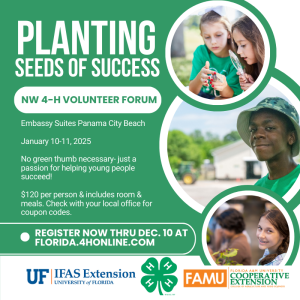 Dates: January 10-11, 2025
Dates: January 10-11, 2025
Location: Panama City Beach, FL
Are you excited about helping young people grow? Do you want to become a stronger leader and connect with others who share your passion? Then save the date for the Northwest 4-H Volunteer Forum in Panama City Beach! We’re looking forward to a weekend filled with learning, fun, and connection. This forum is a great chance for 4-H volunteers to gain new skills, share ideas, and make an even bigger impact on the youth we serve.
Volunteers are the heart of 4-H. You play a vital role in mentoring young people and helping them grow in projects like agriculture, science, health, and citizenship. Without your time and dedication, 4-H wouldn’t be able to fulfill its mission to empower and guide the next generation.
One of the best parts of attending the forum is the chance to network with fellow volunteers. Connecting with others who share your passion for 4-H opens the door to collaboration and learning from each other’s experiences. By building communities of practice, we strengthen our local programs and create lasting partnerships that help us serve youth more effectively. These connections can lead to new ideas, shared resources, and ongoing support from others who understand the challenges and rewards of volunteering.
At the forum, you’ll have the chance to attend workshops designed to strengthen leadership, build new programs, and provide helpful tips for mentoring youth. These sessions will be led by experienced 4-H Agents and volunteers who can’t wait to share their insights. You’ll leave with fresh ideas and skills to take back to your 4-H community, helping to make an even bigger difference.
Register today to be part of this exciting opportunity! Not only will you grow as a leader, but you’ll also contribute to the success of 4-H for years to come. Let’s work together to inspire the next generation of leaders and problem-solvers. Don’t miss out—come grow, connect, and lead with us!
Feel free to share this invitation with other volunteers or anyone interested in supporting 4-H. Let’s grow together!
Register in 4Honline now through December 10th.
by Valerie Mendez Stansly | Mar 28, 2024
As we continue with part two of our series ‘Planning a Safe and Engaging Paddling Adventure for Youth,’ our goal is to highlight the key elements that make these excursions both memorable and educational. You will be introduced to the essentials of group dynamics, communication strategies, and incorporating educational components to your trip. Whether you’re planning a day trip or a multi-day camp, the information in this blog will help you navigate the challenges and delights of introducing young paddlers to the wonders of the great outdoors.
Paddling is a Group Activity
A successful paddling trip depends greatly on strong group dynamics and clear communication. Prior to getting on the water, it’s essential to conduct a thorough on-land training session that covers the basics of paddling, maintaining balance, and methods for recovering from a capsize. Turning these drills into interactive and enjoyable activities can greatly alleviate any nervousness and boost the confidence of your youth participants. For those organizing multi-day camps, scheduling this training a day in advance can be particularly beneficial—the more familiar youth become with these practices, the better.
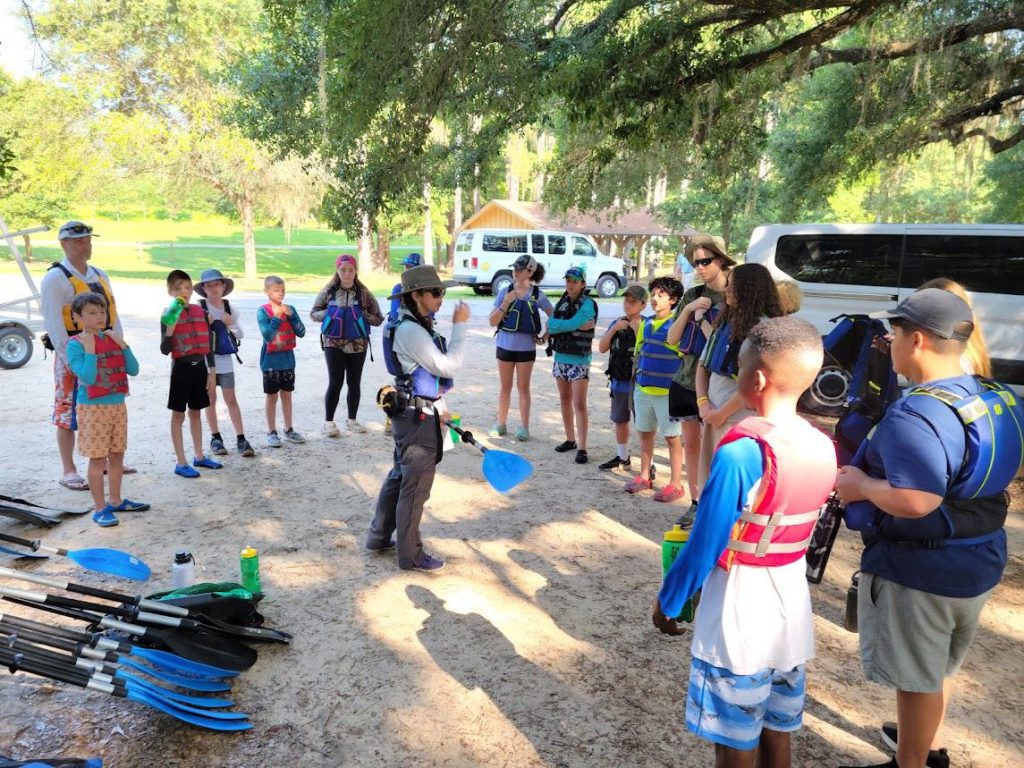
A successful paddling trip fosters solid group dynamics, clear communication, and teachers essential on-land training that covers paddling fundamentals, balance maintenance, and capsize recovery techniques.
Before setting out, it’s important that designated adult volunteers take on the specific roles, such as the lead and sweep, to maintain order and ensure the group’s safety throughout the adventure. The lead is responsible for navigating the route, monitoring for hazards, being mindful of other waterway users, and setting a pace that accommodates the entire group. The sweep boat, positioned at the end of the group, ensures that no one falls behind. This position requires experience with rescue situations, the capability to offer aid during capsizes or emergencies, and typically includes the responsibility of carrying a first aid kit along with having certifications in first aid, and CPR.
Effective and clear communication is essential when on the water. All paddlers should stay within earshot of each other to facilitate this. However, if distance makes verbal communication challenging, hand, paddle, and whistle signals become crucial tools for conveying messages. For instance, holding a paddle horizontally above your head signals others to stop paddling. Raising your arms vertically signifies an all-clear or prompts others to proceed. Waving your paddle overhead indicates a need for assistance in emergencies. To direct paddlers, use your paddle to point in the intended direction of travel, avoiding using it to point out hazards.
Whistle signals also play a key role in communication:
- One whistle blast calls for attention, urging the group to stop and wait for further instructions.
- Two blasts instruct paddlers to stop and remain in their current location.
- Three blasts signal an emergency, indicating that help is needed.
By creating clear communication among experienced adults, the trip not only becomes safer but also serves as an opportunity to demonstrate responsibility and leadership to youth on the trip. This structure provides a secure environment where youth can focus on refining their paddling skills and fully engage in the educational aspects of the activity. Modeling teamwork within the adults fosters a sense of unity throughout the team, enabling everyone to navigate challenges more effectively.
In case of a Capsize
When someone capsizes, it’s essential to remember your rescue priorities. The safety of people is always the most important. First, make sure everyone is safe. Then, collect boats and paddles. After securing the larger items, you can retrieve smaller gear like water bottles and dry bags.
If you’re the rescuer, it’s crucial to stay calm and control your boat to avoid becoming a casualty yourself. Ask for help if needed, giving clear instructions to the victim or other group members. If you’re witnessing a capsize, sometimes the best action is to stay clear unless the rescuer calls for assistance. If asked to help, follow their instructions while keeping yourself and your boat under control.
As a potential rescuer, remember the sequence talk – reach – throw – paddle – go.
- Talk: Start by getting the attention of the capsized paddler using your voice, whistle, or another sound device. Often, simply talking them through staying calm and performing a self-rescue is enough.
- Reach: If more than verbal guidance is needed, use the reach method. Extend your paddle or arm to help. Guide them to the front of your kayak for safety, avoiding having them hold onto the side, which could destabilize your kayak.
- Throw: When the capsized paddler is too far for a reach, throw them a rope or a life float they can grab onto.
- Paddle: If neither talking, reaching, nor throwing works, paddle close enough to them so they can be safely pulled to safety using the reach or throw method.
- Go: As a last resort, you may need to get into the water to assist, which involves significant risk. Ensure bystanders are calling for help while you swim to the capsized paddler’s aid.
This approach ensures everyone knows their role in a capsize situation, prioritizing safety and effective rescue techniques.
Outdoor Education and Stewardship
Enhance your paddling journey by turning it into a comprehensive educational experience, focusing on the local ecosystem and conservation initiatives. By immersing participants in the surrounding natural environment, you deepen their connection and commitment to environmental stewardship.
Teaching and practicing Leave No Trace principles is key to fostering respect for our natural surroundings. Paddling leaders play a crucial role in emphasizing the importance of minimizing our environmental impact, showing consideration for wildlife, and preserving the natural beauty of our waterways. Instilling these values in young paddlers helps them understand the critical role they play in conservation efforts and encourages them to engage in responsible outdoor behaviors well into adulthood.
Reflection
Incorporating a debrief, or post-trip reflection session, into your paddling adventure is an excellent way to incorporate principles of experiential learning, which values learning through action and reflection. After your trip, taking time for a debrief enables participants to express their thoughts on the activity, confront challenges encountered, and share new insights. Purposeful reflection is essential to the experiential learning process, helping learners to internalize their experiences and apply their insights in future contexts.
Debriefing among adults is also important. Scenarios encountered during the trip may highlight potential opportunities where additional training from certified instructors to improve paddling skills and safety knowledge is needed.
Conclusion
Embarking on a paddling adventure with youth offers more than just a day on the water; it’s an opportunity to foster teamwork, respect for nature, and a commitment to environmental stewardship through experiential learning. By incorporating safety, education, and reflection, we not only ensure a memorable and enriching experience but also instill important values and skills that youth will carry with them long after the trip ends.
Resources:
Want to learn more? Check out Paddle TV on YouTube which has made great videos in partnership with the American Canoe Association (ACA) by following the link: https://americancanoe.org/education/youth-paddling-development/educational-videos/
Consider using the Paddle Safe Paddle Smart (PS2) curriculum that has been created by ACA when implementing a paddling component during day camps or workshops.
Paddling Trip Checklist for Leaders
This checklist serves as a foundational tool for leaders to ensure that every aspect of the paddling trip is accounted for, from safety to environmental education. By following this guide and utilizing the checklist, leaders can provide a safe, enjoyable, and enriching paddling experience that youth participants will remember for years to come.
by Valerie Mendez Stansly | Mar 21, 2024
Setting off on a paddling adventure with youth, whether it involves canoeing, kayaking, or stand-up paddleboarding (SUP), offers a wonderful opportunity for them to get active, connect with the outdoors, and learn the value of teamwork. These activities can leave a lasting impression on the young people involved, fostering feelings of accomplishment, resilience, and fellowship. However, the responsibility on the adults leading these trips is significant. Ensuring a safe, educational, and enjoyable experience requires meticulous planning, a focus on safety, and a commitment to engaging each participant. Through this blog series, you will be provided with the insights and tools necessary to organize a successful paddling event for youth.
Securing Kayaks
Safety is the foundation of any successful paddling adventure, especially when involving young people. A critical, yet often overlooked, aspect of this safety is the secure transportation of your kayaks. Begin by firmly attaching your kayaks to your trailer using suitable straps. Before hitting the road, double-check that the straps are tightly fastened, the ends are securely tied off, and the kayak doesn’t move when you gently rock it.
When loading a kayak, always position the straps in advance. It’s a team effort to safely lift the kayak by its bow (front) and stern (back) handles—remembering to bend at the knees to protect your back. Once the kayak is evenly placed on the trailer’s crossbars, secure it properly by using the appropriate ties. Although ratcheting straps are commonly used, they can potentially damage your kayak due to excessive pressure. As an alternative, the use of buckle bumper straps offers a safe and user-friendly solution for both novices and experienced paddlers alike. Ensuring your kayaks are safely secured not only protects your equipment but also ensures the safety of everyone on the road.
Planning is Essential – Crafting a Float Plan
The backbone of a smooth paddling adventure is a detailed float plan. This document should outline your route, expected weather conditions, participant list with emergency contacts, and a timeline of the trip. Utilizing resources such as the Coast Guard Float Plan Central website ensures you don’t miss any critical planning steps. Your float plan should include not only the basics but also specific details such as the equipment each person will bring, health forms, expected departure and return times, access points, and the driving route. It’s also vital to assess and document the day’s weather, tides, water flow, and temperature, alongside local regulations, necessary permits, and the nearest emergency services and outfitters.
In addition to creating a comprehensive float plan, it’s essential to pack necessary items like water, snacks, sunscreen, and first-aid supplies, while encouraging lightweight packing to minimize the physical load on paddlers. Ensure that agents and other adults in charge involved are well-informed about the float plan, current and forecasted weather conditions, and the personal skills and comfort levels within the group.
Remember, the float plan is not just a list; it’s a snapshot of your group’s capabilities, equipment, and safety resources. Items not directly related to trip planning and participant safety should be recorded separately. Always leave the float plan with someone on shore who is familiar with the trip details, participants, and local area. This person’s responsibility is to alert local authorities should the group not return as scheduled. Typically, float plans are best entrusted to an agent and/or county extension director.
When you are out on the water, pay close attention to changing weather conditions. If the weather gets challenging, ensure your group stays together and maintains steady communication. In the case of unexpected thunder, lightning, heavy rain, or strong wind, find a protected area on land for the group to escape the elements. If the group gets off the water, be sure that boats or boards are far away from the water’s edge. Make sure to take all paddles and any food, water, and personal gear are with youth.
Choosing the Right Gear
Personal gear and preparedness are crucial for the success of your paddling trip. When choosing a paddling outfit, prioritize versatility, durability, and protection against cold, and wet conditions. Here are some key guidelines:
- Personal Flotation Device (PFD): Always wear a PFD while on the water. Ensure it fits snugly without riding up over your face or head. If adjustments are needed, do so safely onshore.
- Temperature Considerations: Youth and adults should dress for potential immersion. Hypothermia, a dangerous drop in body temperature, can occur in water temperatures as “warm” as 70 degrees Fahrenheit, according to U.S. Coast Guard. Conversely, hyperthermia results from overheating, often due to hot, humid conditions. Dressing in layers will help adjust for body temperature changes during the trip.
- Sun Protection: Applying sunscreen is critical for preventing sunburn and overheating, even on cloudy days. Due to the reflective nature of water, apply sunscreen often. Mineral sunscreen, with zinc oxide or titanium dioxide, forms a barrier against UV rays with a reduce risk of irritation or allergic reaction and is favored by many paddlers.
- Avoid cotton and restrictive clothing: Steer clear of cotton clothing such as jeans and hoodies, which retain water when wet. Instead choose garments made from quick-drying, moisture-wicking synthetics, or wool, which provide insulation even when wet. Fortunately, outfitting yourself appropriately doesn’t have to break the bank—many of these items can be readily found at affordable prices in secondhand stores like Goodwill.
By following safety guidelines and preparing with the right gear, paddlers can enjoy a safe and comfortable experience on the water, ready to face varying temperatures and conditions with confidence. In the next blog, we will discuss group management and safety considerations to take while on the water.
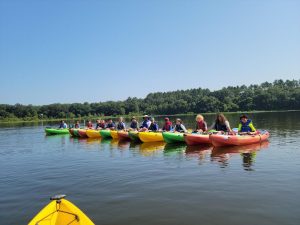
Introducing youth to the joys of paddling can create unforgettable memories that last a lifetime. At the same time, it’s crucial that we, as adults, prioritize their safety above all.
Resources:
Want to learn more? Check out Paddle TV on YouTube which has made great videos in partnership with the American Canoe Association (ACA) by following this link: https://americancanoe.org/education/youth-paddling-development/educational-videos/
Consider using the Paddle Safe Paddle Smart (PS2) curriculum that has been created by ACA when implementing a paddling component during day camps or workshops.

by lauenc | Jul 6, 2023
In today’s fast-paced digital age, it’s essential for young minds to engage in activities that foster creativity, practical skills, and personal growth. Summer day camps with 4-H provide an excellent opportunity for youth to explore their interests and develop new talents while having “sew” much fun! Thanks to the Florida 4-H Foundation’s Clothing, Textiles, and Fashion Mini Grant, supported by JOANN Fabric and Craft, Holmes County 4-H Sewing Summer Day Camp was made possible. In this post, you will discover the enriching experiences and valuable lessons that 4-H members gained while immersing themselves in the world of sewing, textiles, and fashion.
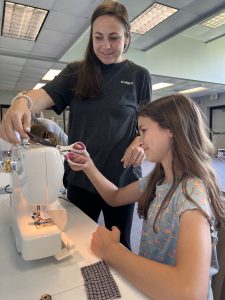
Nurturing Creativity:
At the heart of the sewing summer day camp lies the spirit of creativity. Through hands-on projects and guided instruction, participants discovered the joy of transforming fabrics into unique and stylish creations. From selecting patterns and colors to sewing intricate details, campers were encouraged to let their imagination soar. The camp provided a safe and supportive environment for young minds to explore their creativity, leading to the development of innovative designs and personal style.
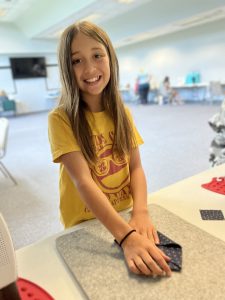
Building Practical Skills:
Sewing is a practical skill that cultivates patience, precision, and problem-solving abilities. Throughout the camp, youth were introduced to the fundamentals of sewing, including understanding different fabrics, operating sewing machines, and mastering essential stitching techniques. Under the guidance of experienced instructors, participants progressively honed their skills, learning how to read patterns, measure and cut fabric, and assemble garments with finesse. These newfound skills empowered the youth to embark on independent sewing projects beyond the camp.

Fostering Teamwork and Collaboration:
The sewing summer day camp fostered an environment of teamwork and collaboration, where participants worked together to complete various sewing projects. Whether assisting each other with challenging stitching or providing creative input during design discussions, campers learned the value of cooperation and the power of collective effort. Through these interactions, they discovered that the world of sewing extends beyond individual endeavors and that sharing knowledge and skills can enhance everyone’s experience.
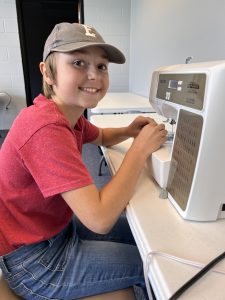
Cultivating Attention to Detail:
Precision and attention to detail are crucial aspects of sewing. Throughout the camp, participants were encouraged to carefully measure, cut, and sew fabrics to achieve flawless results. They learned the importance of meticulous planning, double-checking measurements, and maintaining focus throughout the sewing process. Cultivating this attention to detail not only improved their sewing outcomes but also instilled in them a valuable life skill applicable in various contexts.
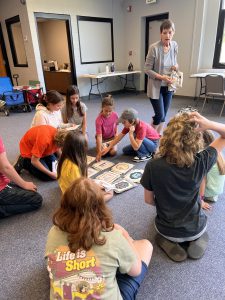
Navigating Fashion Trends and Sustainability:
Through engaging discussions and interactive sessions, campers explored the concepts of fashion, upcycling, and sustainable fabric choices. They gained an understanding of the environmental impact of fast fashion and discovered how they can make a positive difference by embracing sustainable practices in their own sewing projects and daily lives.
The Holmes County 4-H Sewing Summer Day Camp, made possible by the Florida 4-H Foundation’s Clothing, Textiles, and Fashion Mini Grant supported by JOANN Fabric and Craft, offered an incredible opportunity for youth to explore the world of sewing, textiles, and fashion. Participants not only developed practical sewing skills, but also nurtured their creativity, fostered teamwork, honed attention to detail, and gained insights into sustainable fashion practices. Through this enriching experience, 4-H youth were empowered to express their individuality, explore their passions, and embark on a lifelong journey of creativity and self-discovery.
For more information about upcoming youth programming related to sewing, textiles, and fashion with Holmes County 4-H, visit the UF IFAS Extension Holmes County 4-H Facebook page or contact the Holmes County 4-H Agent at 850-547-1108.
To learn more about how JOANN can support 4-H programming in your county, visit 4-H | JOANN Discount Program.
#JOANNLOVES4H
@Florida4H
by Rachel Pienta | May 26, 2023
What does it mean to be a coach? When you hear the word coach, do you picture someone with a whistle on a sports field? Most of us are probably familiar with sports coaching. However, the concept of coaching has grown to include life and professional coaching as well! This expansion of coaching has established that it is a skill that has applications across a broad array of life situations.
If you google professional coaching, you will find a plethora of books available on the topic. Writer Julie Starr has identified several fundamental coaching skills: building rapport, listening, asking good questions, and giving constructive feedback (Starr, 2021). Those skills sound like the characteristics agents hope to find in a 4-H volunteer!
How Is Coaching Different From Mentoring?
How does coaching differ from mentoring? Zust (2017) contrasted coaching versus mentoring in the business setting, explaining that coaching is a partnership between the coach and the person receiving coaching. The coach helps an individual or team reach or grow toward their potential. Just as a sports coach has a season, a coach in the business setting helps the person or team to reach a goal. How does coaching translate to the 4-H setting? In 4-H, youth may want to complete a project or compete in an event. As a volunteer, you can help coach them through a successful experience! In contrast, Zust (2017) characterizes mentoring as a longer term, developmental process that may not be focused on one particular event or project. In an earlier blog post, I addressed types of mentoring and mentoring practices.
As a volunteer, you may recognize that the 4-H agent you work with has been coaching you! As a 4-H club volunteer, you also have the opportunity to coach the youth enrolled in the 4-H program. In this blog post, you will learn about coaching techniques and how to be a more effective coach to the youth in your clubs. What does it mean to be effective as a coach? In the context of youth development, coaching effectiveness can be defined as the integrated application of “professional, interpersonal, and intrapersonal knowledge to improve youth competence, confidence, connection and character” (Vella et al, 2011).
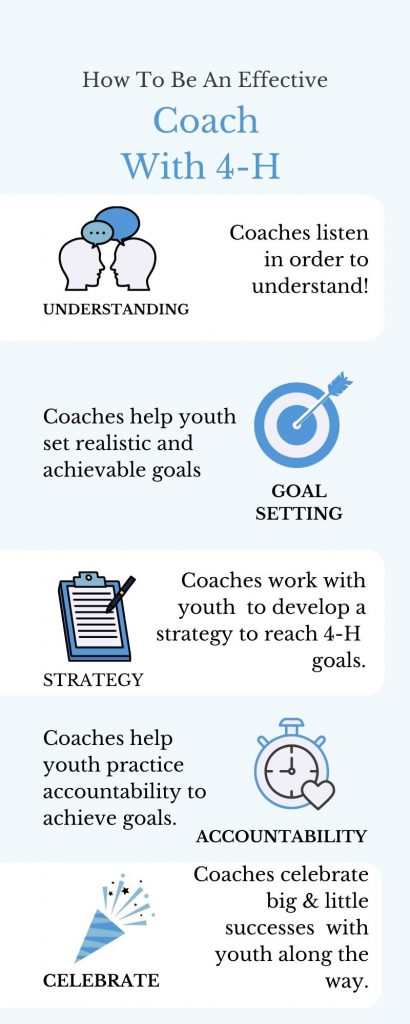
4-H coaches help youth achieve their goals.
Getting in the Zone (of Proximal Development)
To better understand how to effectively implement coaching with youth, we will consider the following learning concepts: the Zone of Proximal Development (ZPD) and “scaffolding” (Vinson and Parker, 2019). Vygotsky (1978) defined ZPD as the “distance between actual developmental level as determined by independent problem-solving and the level of potential development as determined through problem-solving under adult guidance or in collaboration with more capable peers.” When I read Vygotsky’s definition of ZPD, I immediately think, “That’s 4-H!” Youth are able to develop and improve skills, ultimately achieving more with the support of caring adults. In 4-H, we also encourage youth to apply what they have learned through teaching others. Several coaching behaviors suggested by Vygotsky include “questioning, demonstrating and introducing the beginnings of task solution” (Vinson and Parker, 2019). These behaviors are ways to use scaffolding as a technique in youth development.
How to Incorporate Scaffolding into Your Coaching Toolkit
Scaffolding is a learning process that can be used as a technique in effective coaching. This technique can help youth build on existing knowledge they have previously acquired. The process works similarly for skill-building and “Scaffolding practices provide the opportunity for children to reach higher-level skills by building on and extending their existing skills” (Mincemoyer, 2016). Three examples of scaffolding strategies that can be used to coach 4-H youth include:
- Modeling and demonstrating: Adult volunteers can demonstrate the skill or ask a youth to demonstrate.
- Incorporating reflection into the club meeting: Build in time for youth to explain to you and their peers what they learned during a club activity.
- Using documentation: Illustrated talks and project books are forms of documentation. Youth may document their learning with photographs, written descriptions, and even video. This documentation becomes a foundation to build on moving forward as more skills are developed.
(Adapted from Mincemoyer, 2016).
In closing, you may already be engaging in effective coaching strategies as a 4-H volunteer without knowing that was what you were doing! If coaching is a new concept for you, this blog post should serve as a starting point for further development in your volunteer experience. Your 4-H agent can be an excellent knowledge resource as well as serving in a coaching role for you.
For more information about positive youth development (PYD) strategies or to learn more about becoming a 4-H volunteer, reach out to your local Extension office.
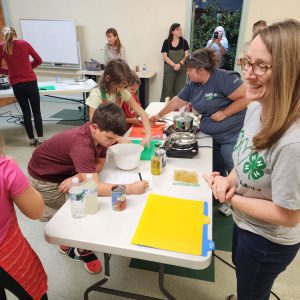
Youth engage in a mock Cooking Challenge with coach support.
Resources for Further Reading
Mincemoyer, C. (2016). “Scaffolding Approaches and Practices.” Penn State Extension. Pennsylvania State University. http://bkc-od-media.vmhost.psu.edu/documents/HO_MIL_GI_Scaffolding.pdf
Starr, J. (2021). The Coaching Manual. 5th edition. Pearson Business.
Vella, Stewart & Oades, Lindsay & Crowe, Trevor. (2011). The Role of the Coach in Facilitating Positive Youth Development: Moving from Theory to Practice. Journal of Applied Sport Psychology. 23. 33-48. 10.1080/10413200.2010.511423.
Vinson, D. and Parker, A. (2019) Vygotsky and Sports Coaching: Non-linear practice in youth and adult settings. Curriculum Studies in Health and Physical Education, 10 (1). pp. 91-106. doi:10.1080/25742981.2018.1555003 ORCID: 0000-0001-6842-3067
Vygotsky, L. S. (1978). Mind in Society: The development of higher psychological processes. Harvard: Harvard University Press.
Zust, C. (2017). “Know the Difference Between Coaching and Mentoring.” Kent State University. https://www.kent.edu/yourtrainingpartner/know-difference-between-coaching-and-mentoring
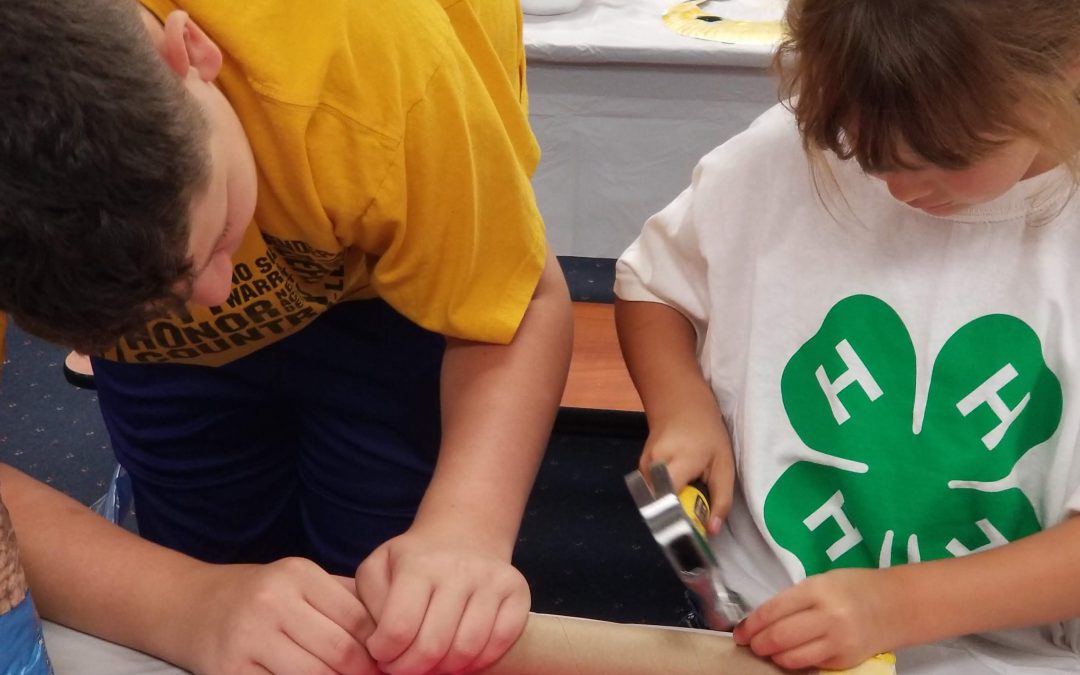
by Niki Crawson | May 19, 2023
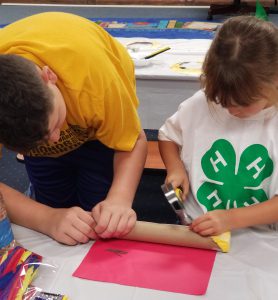
We know that younger youth look up to older youth and like to model their behaviors. We see it in siblings all the time, absorbing behaviors of their older brothers or sisters like sponges. Often times, younger youth find the attention and encouragement of older youth more relatable due to the closeness in age. Peer teaching fosters a more engaging and even symbiotic learning experience as this gives teens the opportunity to share and reinforce their own knowledge. In addition, by pairing the two age groups together in a learning environment, a sense of comradery can develop, creating a greater sense of belonging within the 4-H community. In this post, we will define peer teaching, share a few examples of how to utilize your teens as teachers and provide tips for getting peer teaching started in your clubs and other 4-H events and activities successfully.
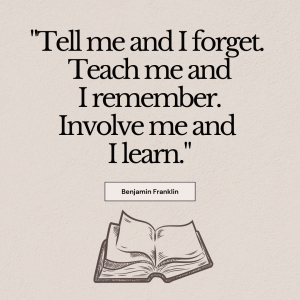
WHAT IS PEER TEACHING?
What do we mean by peer teaching exactly? It is the process of youth learning together and from each other through engaging, hands-on activities. In 4-H, we have the wonderful ability to utilize teens as volunteers and positive role models for our younger youth in our positive youth development programs. Empowering our teens as teachers for our younger members allows life skills to develop among our youth being instructed and also the instructors. The teen instructors are teaching specific topics to their peers at the same time they are strengthening their own leadership, communication, and social skills.
WHAT ARE THE BENEFITS OF PEER TEACHING?
As stated previously, one of the greatest outcomes is that the teacher and the student both gain knowledge and skills. It creates a mutually beneficial environment in which all youth can achieve personal growth and development if implemented and managed correctly. In addition, there are many other benefits of peer teaching such as:
- Peers being taught may form a quicker and better connection with teens due to communication, technology and other trends.
- An increase in peer confidence as they may feel more comfortable in asking questions, discussing topics with others closer to their age.
- Greater creativity as teens may have more innovative or modern ideas to bring to the activities.
- An increase in volunteers as teens have the ability to recruit more teens easier than typical adult volunteers.
- An increase in retention of youth as peers stay in the program and become the next generation of teen volunteers/teachers.
WHAT DOES PEER TEACHING LOOK LIKE IN 4-H?
Below are just a few programs for teens to practice the method of peer teaching in their 4-H county:
- New Members – When new youth join 4-H, it can be overwhelming at times to learn some of the 4-H activities, customs, and such. This would be a great opportunity for
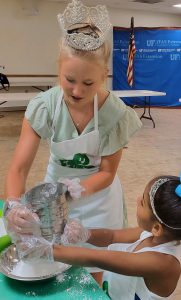 peer teaching. Have teens assigned to new members that join in order to teach them the 4-H pledge, motto, club expectations, member names, etc. This creates a greater sense of belonging and fosters a supportive environment within the club for new members to engage more quickly and successfully.
peer teaching. Have teens assigned to new members that join in order to teach them the 4-H pledge, motto, club expectations, member names, etc. This creates a greater sense of belonging and fosters a supportive environment within the club for new members to engage more quickly and successfully.
- Cloverbud Club Meetings – Utilizing your teen members in club meetings involving Cloverbuds (members ages 5-7) is a great way to incorporate peer teaching in your 4-H program. Younger members thrive off of creativity and enthusiasm which teens often portray easily. Teens can funnel this energy into teaching lessons to Cloverbuds that are engaging and interactive in a simplistic way.
- Summer Day Camps – 4-H programs often times need additional volunteers during the summer to assist with the volume of programming and youth participants. Therefore, summer is a great time to recruit teens to become peer teachers. Having teens as peer teachers helps with supervision and instruction while at the same time, allows them to stay involved in 4-H, continue to apply their life skills learned, and help the program teach life skills to other youth in the community.
TIPS TO GET PEER TEACHING STARTED IN YOUR 4-H COUNTY
What does it take to get peer teaching started in your 4-H county? Time and patience to start with. Teaching with teens is an ongoing task and will take a little effort on your part. Below are a few tips to get you started on having teens peer teach in your county:
- Identify programming that would benefit by peer teaching.
- Recruit quality teen teachers.
- Train and support teens as peer teachers.
- Assign teens appropriate roles in the peer teacher process.
- Model appropriate teaching methods in 4-H programs.
- Shadow teens in the role as peer teachers to provide support and guidance.
- Evaluate, provide feedback, and continue professional development for continued success.
Remember, peer teaching is a great way to utilize teen members in your 4-H programs. Younger youth need as many positive role models as possible in their lives. By having teen teachers take the lead in instruction in your 4-H programs, you are fostering an environment of learning, inclusivity, empowerment, and leadership.
To learn more about 4-H opportunities where teens can take the lead as teachers for their peers, please contact your local UF IFAS County Extension Office, or visit http://florida4h.org.
ADDITIONAL SOURCES:
Burse, G., Crocker, E. T., Jordan, J., McKinney, M., & Murphy, L. (2021). Teens as Teachers 4-H Project: Curriculum and Resources. UF/IFAS Extension, University of Florida. Retrieved May 1, 2023, from https://edis.ifas.ufl.edu/publication/4H432
Eckhoff, A., & Swistock, B. (2011). Staffing with Teenagers and Teens as Cross-Age Teachers. Rutgers Cooperative Extension.
 Dates: January 10-11, 2025
Dates: January 10-11, 2025













